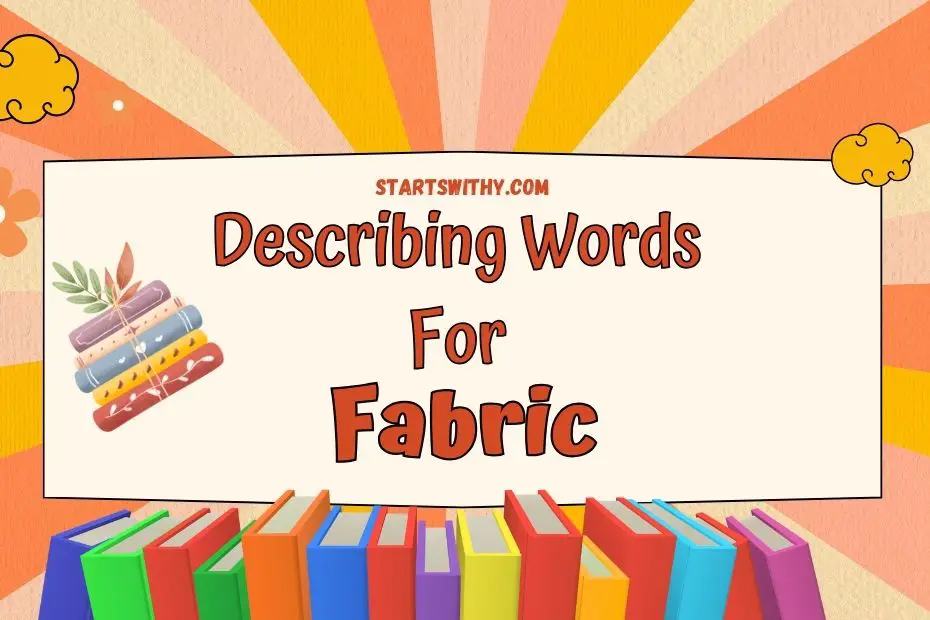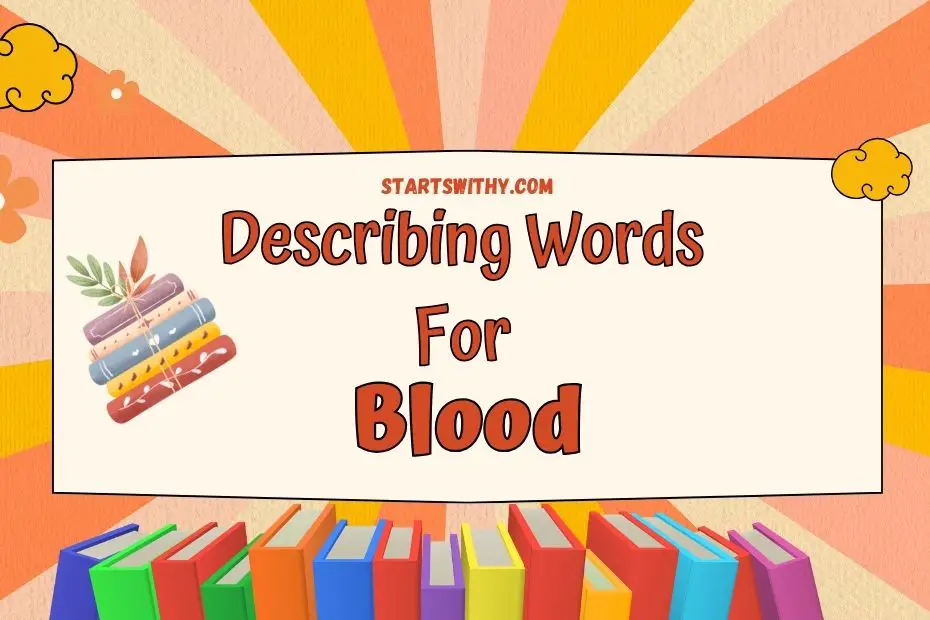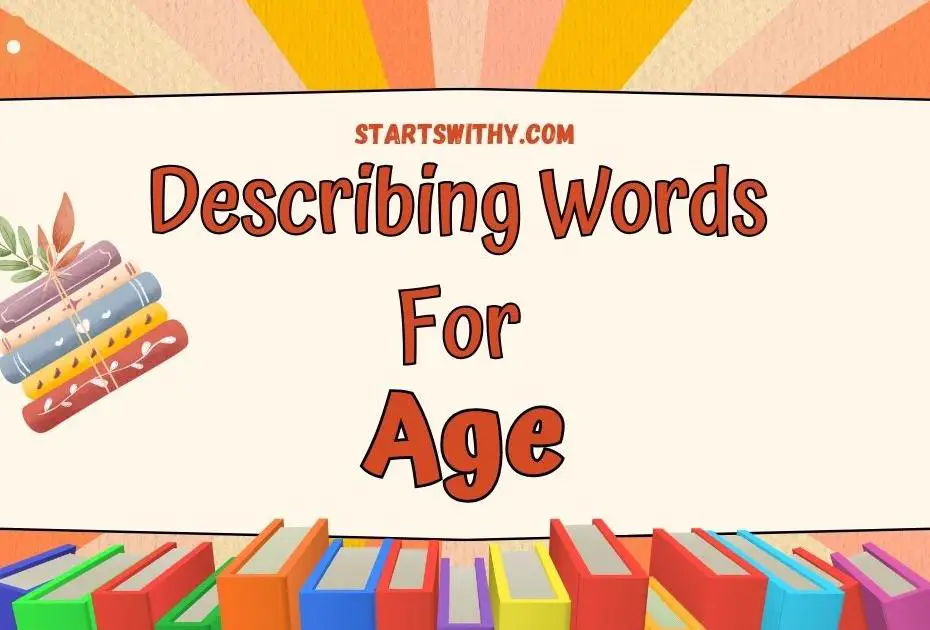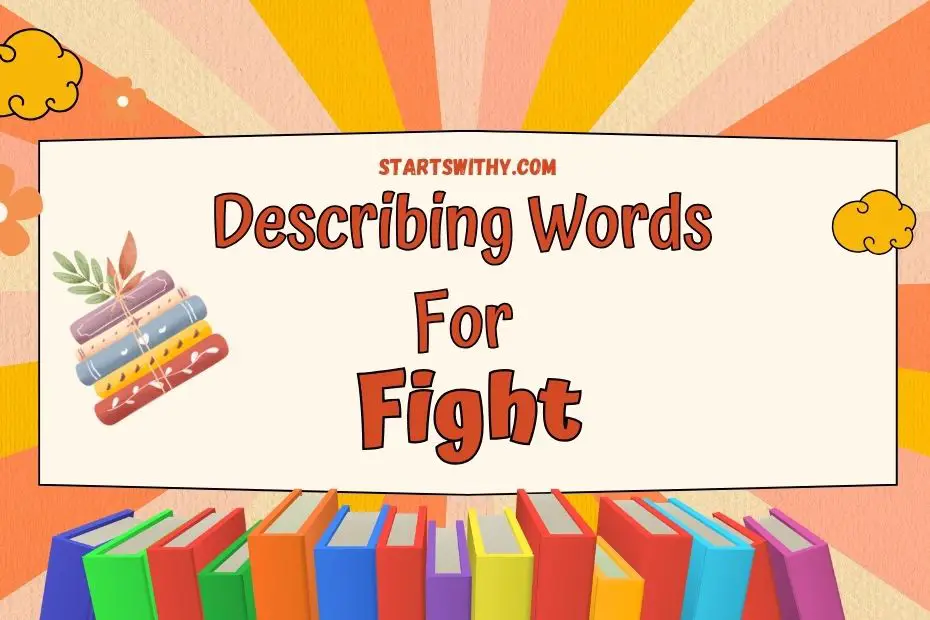When it comes to describing fabrics, the right adjectives can make all the difference. Whether you’re a fashion enthusiast or simply someone who appreciates the feel and texture of different materials, having a diverse vocabulary of fabric adjectives can help you express your thoughts and preferences with precision. In this article, I’ll be sharing a collection of descriptive words that will bring fabrics to life, along with examples to illustrate their usage. From soft and luxurious to sturdy and durable, get ready to explore the world of fabric adjectives and enhance your ability to describe the textiles around you.
From the smoothness of silk to the warmth of wool, fabrics have the power to evoke a range of emotions and sensations. By using the right adjectives, you can paint a vivid picture of how a particular fabric looks, feels, and behaves. Are you curious about the difference between a fabric that’s lightweight and one that’s delicate? Or perhaps you want to know how to describe a fabric that’s both lustrous and durable? Look no further. In this article, I’ll be sharing a comprehensive list of adjectives for fabric, complete with examples, so you can confidently express yourself when discussing textiles. So, let’s dive into the world of fabric adjectives and discover the perfect words to describe your favorite materials.
How to Describe fabric? – Different Scenarios
When it comes to describing fabric, it’s important to choose the right words to accurately convey its characteristics. Whether you’re a fashion designer explaining your vision, a textile enthusiast sharing your thoughts, or simply looking for the perfect fabric for your project, having a diverse vocabulary of fabric adjectives can help you express your ideas with precision. Let’s explore some different scenarios and how to describe fabric in each one:
Describing Fabric for Clothing:
- Comfort and Wear:
- Silky-soft: Luxuriously smooth against the skin, perfect for drapey dresses and flowing tops.
- Breathable cotton: Lightweight and airy, ideal for everyday wear and warm climates.
- Cozy fleece: Warm and inviting, perfect for sweaters and loungewear.
- Durable denim: Strong and resilient, ideal for jeans and jackets.
- Style and Texture:
- Crinkled linen: Adds a touch of rustic charm to shirts and dresses.
- Satin sheen: Creates a glamorous look for evening wear and special occasions.
- Supple leather: Luxurious and timeless, perfect for jackets, skirts, and accessories.
- Textured knit: Adds visual interest and warmth to sweaters and scarves.
- Function and Movement:
- Stretchy jersey: Ideal for activewear and comfortable clothing that moves with you.
- Wrinkle-resistant: Perfect for travel and busy lifestyles.
- Water-resistant: Ideal for outdoor wear and rain protection.
- Quick-drying: Breathable and practical for activewear and summer clothes.
Describing Fabric for Home Decor:
- Ambiance and Texture:
- Lush velvet: Creates a rich and luxurious feel, perfect for curtains and upholstery.
- Warm chenille: Adds a cozy and inviting touch to throws and blankets.
- Crisp linen: Light and airy, perfect for summer curtains and tablecloths.
- Natural jute: Adds a rustic and earthy feel to rugs and baskets.
- Functionality and Care:
- Stain-resistant: Ideal for high-traffic areas and families with pets.
- Machine-washable: Easy to care for and maintain.
- Fade-resistant: Maintains its color even in direct sunlight.
- Moisture-wicking: Ideal for bathroom towels and kitchen linens.
- Pattern and Color:
- Bold floral prints: Add a touch of vibrancy and personality to cushions and throws.
- Geometric patterns: Create a modern and sophisticated look for curtains and upholstery.
- Neutral tones: Offer a versatile base for layering different textures and patterns.
- Muted pastels: Create a calming and serene atmosphere in bedrooms and living areas.
Describing Fabric for Special Occasions:
- Elegance and Sophistication:
- Sparkling sequins: Add a touch of glamour and shine to dresses and evening gowns.
- Delicate lace: Creates a romantic and feminine look for special occasions.
- Flowing chiffon: Adds ethereal beauty and movement to dresses and skirts.
- Rich satin: Luxuriously smooth and elegant, perfect for formal wear.
- Impact and Color:
- Bold jewel tones: Make a statement and turn heads at formal events.
- Metallic fabrics: Add a touch of shimmer and glamour to evening wear.
- Subtle pastels: Offer a sophisticated and elegant look for formal occasions.
- Classic black or white: Timeless and versatile, perfect for formal events and black-tie attire.
- Texture and Details:
- Embroidered embellishments: Add a touch of luxury and craftsmanship to dresses and jackets.
- Ruffled accents: Create a playful and romantic look for special occasions.
- Pleated details: Add visual interest and movement to skirts and dresses.
- Sequined appliqués: Add a touch of sparkle and shine to formal wear.
Describing Fabric for Crafts:
- Workability and Texture:
- Felt: Soft and easy to cut, perfect for sewing crafts, toys, and decorations.
- Cotton canvas: Durable and versatile, ideal for bags, tote bags, and home decor projects.
- Faux leather: Adds a professional touch to wallets, clutches, and other accessories.
- Quilting cotton: Lightweight and easy to sew, perfect for quilts, pillows, and other patchwork projects.
- Color and Pattern:
- Vibrant prints: Add a fun and playful touch to quilts, bags, and other crafts.
- Solid colors: Offer a versatile base for layering and creating patterns.
- Metallic fabrics: Add a touch of sparkle and shine to craft projects.
- Natural tones: Create a rustic and earthy feel for home decor projects.
- Specific Uses and Techniques:
- Drapey fabrics: Ideal for curtains, tablecloths, and other home decor projects.
- Stiff fabrics: Perfect for creating structured projects like bags and boxes.
Remember, the key to describing fabric is to consider its texture, weight, drape, durability, and overall aesthetic. By using the right adjectives, you can paint a vivid picture of how a particular fabric looks, feels, and behaves. So, next time you find yourself in need of describing fabric, don’t hesitate to get creative with your vocabulary and create a more engaging and accurate description.
Let’s dive into a comprehensive list of fabric adjectives with examples to further enhance your ability to describe textiles.
Describing Words for fabric in English
When it comes to describing fabrics, having a diverse vocabulary is essential. The right adjectives can accurately convey the characteristics of a fabric, whether it’s for clothing, home decor, special occasions, or crafts. As someone with years of experience in the industry, I have compiled a comprehensive list of describing words for fabric, along with examples, to help you enhance your ability to describe textiles. Let’s dive in!
Texture
- Smooth: This fabric has a sleek and velvety feel to it. Example: silk.
- Coarse: It has a rough and uneven texture. Example: burlap.
- Soft: It’s gentle and cushiony to the touch. Example: cotton.
- Rough: This fabric has a rugged and abrasive surface. Example: denim.
- Satin: It has a smooth and lustrous feel. Example: satin fabric.
Weight
- Lightweight: This fabric is easy to handle and feels light. Example: chiffon.
- Heavy: It has a substantial weight and feels solid. Example: denim.
- Bulky: This fabric is thick and takes up a lot of space. Example: fleece.
- Sheer: It’s almost transparent and lightweight. Example: organza.
- Thin: This fabric is delicate and not very substantial. Example: voile.
Appearance
- Shiny: This fabric has a glossy and reflective surface. Example: satin.
- Matte: It has a non-shiny and dull appearance. Example: linen.
- Sparkling: This fabric has small glitters or sequins. Example: sequin fabric.
- Vibrant: It has bright and bold colors. Example: printed cotton.
- Dull: This fabric has a lackluster and muted appearance. Example: tweed.
- Striped: This fabric has parallel lines of different colors or widths. Example: striped cotton.
- Floral: It features flowers or plants as part of its design. Example: floral print.
- Polka Dot: It has a repeating pattern of round dots. Example: polka dot fabric.
- Geometric: This fabric showcases shapes like squares, triangles, or circles. Example: geometric print.
- Plaid: It has intersecting lines forming squares or rectangles. Example: plaid fabric.
Adjectives for fabric
As an expert in textiles, I understand the importance of using the right adjectives to describe fabric. Whether you’re talking about clothing, home decor, special occasions, or crafts, the right words can bring your descriptions to life. In this section, I’ll provide you with a variety of adjectives for fabric, categorized by their positive and negative qualities. Let’s dive in!
Positive Adjectives for Fabric with Examples
When it comes to describing fabric in a positive light, there are many adjectives you can use. Here are twelve examples with accompanying sentences to help you understand how to use them effectively:
| Adjective | Sentence |
|---|---|
| Soft | “The blanket is soft and cozy, perfect for snuggling.” |
| Smooth | “Her dress felt smooth against her skin.” |
| Silky | “The curtains have a beautiful, silky texture.” |
| Luxurious | “This scarf is made from luxurious cashmere.” |
| Shimmering | “The evening gown was breathtaking with its shimmering fabric.” |
| Lightweight | “I prefer wearing lightweight fabrics in the summer.” |
| Breathable | “The cotton fabric is highly breathable and perfect for warm weather.” |
| Durable | “This upholstery fabric is known for its durable quality.” |
| Elegant | “The silk blouse gave her a wonderfully elegant look.” |
| Vibrant | “The curtains brighten up the room with their vibrant colors.” |
| Textured | “The handmade pillowcase has a unique textured pattern.” |
| Lustrous | “The satin fabric has a lustrous sheen that catches the light.” |
Negative Adjectives for Fabric with Examples
While it’s important to highlight the positive attributes of fabric, it can also be useful to know the negative qualities to avoid. Here are five examples of negative adjectives for fabric:
| Adjective | Sentence |
|---|---|
| Scratchy | “The old wool sweater is scratchy and uncomfortable.” |
| Itchy | “This fabric is so itchy, I can’t wait to take it off.” |
| Stiff | “The denim fabric is too stiff for my liking.” |
| Faded | “The color of this fabric has become faded over time.” |
| Pilling | “The fabric has started pilling, making it look worn out.” |
By incorporating these adjectives into your descriptions, you’ll be able to paint a vivid picture of the fabric you’re discussing. Remember, having a diverse vocabulary allows you to accurately convey the different characteristics of fabric in a more creative and engaging way.
Synonyms and Antonyms with Example Sentences
Synonyms for Fabric
When it comes to describing fabric, there are various synonyms that can help enhance your descriptions. Here are some synonyms to add variety and richness to your vocabulary:
- Cloth – A versatile material used for making garments and other textile products.
- Textile – Refers to any material that is woven, knitted, or made from fibers.
- Material – The substance from which a fabric is made.
- Fabrication – The process of manufacturing fabric.
- Textile – A general term for any type of woven or knit fabric.
Using synonyms can provide different shades of meaning and capture the essence of the fabric you are describing.
Example Sentences using Synonyms:
- The dress was made from a delicate fabric with intricate floral patterns.
- The softness of the textile caressed my skin as I wrapped myself in it.
- The shirt was crafted from a durable and breathable material.
- The intricate details of the garment’s fabrication were truly remarkable.
- The store had a wide selection of textiles to choose from for home decor projects.
Antonyms for Fabric
To provide a comprehensive description, you can also use antonyms to contrast the characteristics of different fabrics. Here are some antonyms for fabric:
- Bare – Refers to a lack of fabric or covering.
- Naked – Describes something that is exposed or uncovered.
- Empty – Indicates the absence of fabric or material.
- Transparent – Allows light to pass through and reveals what is behind it.
- Barren – Describes a lack of fabric or texture.
Using antonyms can help create a vivid contrast in your descriptions and highlight specific qualities of the fabric.
- The dress had a delicate lace overlay, leaving certain areas bare and revealing.
- The shirt was so sheer that it left me feeling naked and exposed.
- The pillow was filled with soft fibers, giving it a plush feel, while the cover remained empty.
- The curtain was made from a transparent fabric, allowing sunlight to fill the room.
- The tablecloth felt rough and barren, lacking the comfort and softness of other fabrics.
By incorporating these synonyms and antonyms into your descriptions, you can paint a vivid picture and capture the essence of different fabrics.
Conclusion
In this article, I have discussed the importance of using the right adjectives to describe fabrics in various scenarios. From clothing to home decor, special occasions to crafts, having a diverse vocabulary is crucial in accurately conveying the characteristics of fabric. I have provided a comprehensive list of fabric adjectives for texture, weight, and appearance, along with examples for each category.
To enhance descriptions and create vivid contrasts, I introduced synonyms and antonyms for fabric, along with example sentences. By incorporating these alternatives into your descriptions, you can paint a more vibrant picture and capture the essence of different fabrics.
Remember, the choice of adjectives can greatly impact how others perceive and understand the fabric you are describing. So be creative, experiment with different words, and let your descriptions come to life. Whether you are a fashion enthusiast, a home decorator, or a craft lover, having a rich vocabulary of fabric adjectives will undoubtedly elevate your work and make it more engaging.
So go ahead, explore the world of fabric adjectives, and let your descriptions shine!



